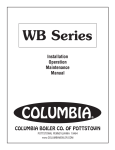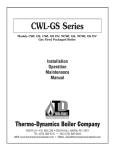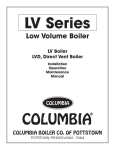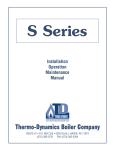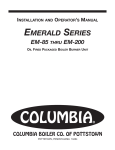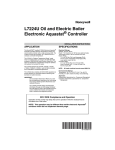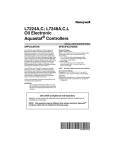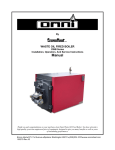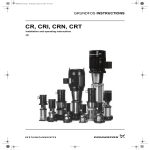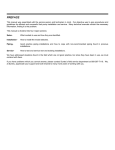Download Beckett AFII 100 Specifications
Transcript
CWL Series - LE Edition Models CWL, NCWL, CWLDV Installation Operation Maintenance Manual www.thermodynamicsboiler.com Thermo-Dynamics Boiler Company ROUTE 61 • P.O. BOX 325 • SCHUYLKILL HAVEN, PA 17972 TEL (570) 385-0731 • FAX (570) 385-5304 WEB www.thermodynamicsboiler.com • EMAIL [email protected] Product Features • • • • • • • • • ASME Coded Boiler Registered with National Board Factory Mounted/Wired Burner and Controls Fully Insulated Heat Exchanger with Powder-Coated Cabinet Packaged with Standard Five Gallon per Minute Tankless Coil (Domestic Hot Water) NCWL Model Available Without Tankless Coil Equipped with Triple Aquastat, Circulator, and Temperature / Altitude Gauge Provided With Additional Nozzles to Achieve a Variety of Heat Inputs Provided with a Lifetime Limited Warranty Available as Direct Vent and Rear Vent Models CWL-LE NCWL CWL-DV Contents Service Policy 2 Homeowner Information 3 Read This First 4 Model Specifications 5 Installation 6 Operation 13 Maintenance 16 Trouble Shooting 17 Parts List 24 Preliminary Settings 25 Wiring Diagrams 27 Burner Service Records Inside Back Cover Service Policy Congratulations on the purchase of your boiler. At Thermo-Dynamics Boiler Company we pride ourselves on the design and construction of our product. Our intent is to furnish you with a high quality appliance that will provide you and your family with years of trouble free service. In order to maintain peak performance of your boiler, it is recommended that the burner/boiler be serviced annually, preferably prior to the onset of the winter heating season. Servicing of your appliance must be performed by a qualified heating technician. You should utilize a qualified heating technician familiar with your installation to manage your heater and perform periodic maintenance. Proper care and maintenance of your boiler will allow you to enjoy the benefits of your new purchase as well as extend its long useful life. In the event that your serviceman encounters difficulty with the boiler, he/she shall contact the distributor from which the product was purchased. The distributor, in turn, will contact the Thermo-Dynamics sales representative for your area. By adhering to this protocol, Thermo-Dynamics will provide you with responsive and unparalleled service. We realize the importance that our product means to you and your family and our goal is to get your heater up and running as quickly as possible. Thank you for purchasing the Thermo-Dynamics boiler. Again, it is our intent to provide you with a high quality trouble free product that will be part of your family for many years to come. Please consider Thermo-Dynamics Boiler Company in the future for all of your home heating needs. 2 HOMEOWNER INFORMATION Heating Contractor: Address: Phone No.: A) General Installation and service is to be done only by a certified and qualified technician. Never burn garbage or refuse in your boiler or leave combustible material around it. Do not allow the fuel tank to run out of oil. The fuel tank should be kept full during the summer, or periods of non-use, to prevent condensation of moisture on the inside of the tank. B) Combustion Air Supply The burner requires an ample amount of clean combustion air to burn efficiently. If ample supply is not available erratic, noisy combustion will result. Under these conditions fuel odors may occur. The installation and use of venting fans (anywhere in the house) or a vented dryer will greatly increase the need for outside air. C) Area Around Boiler The area around the boiler must be kept clean and free of any combustible materials, particularly oily rags or papers. The boiler must be accessible for service. D) Annual Tune-Up The boiler should be serviced once a year, ideally just prior to the heating season. The tune-up is to be done by a qualified technician following procedures listed under Maintenance in this manual E) If Boiler Doesn’t Start: 1) Check if there is fuel in the tank. 2) Is thermostat setting above room temperature. 3) Is service switch in the “on” position. Should there be a problem with operation of the boiler, call a qualified service technician. Do not tamper with the unit or controls. 3 Read This First 1. Installer must be a trained, experienced technician and should read all instructions before installation. 2. Inspect the boiler, jacket and all components to be sure damage has not occurred in shipment. If damage is evident, do not install the boiler. Contact your distributor immediately. A claim must be filed with the freight carrier that transported the boiler from the factory to the distributor. 3. Disconnect power supply before connecting wiring. 4. Refer to local codes for oil burning equipment, for recommended installation practice. You will need to be familiar with NFPA International Standard 31, “Standard for the Installation of Oil Burning Equipment”. 5. A complete heat loss calculation is necessary to choose the proper size unit to install. The boiler should be sized to within 25% of the actual heat loss of the structure. Over sizing will result in short cycling and inefficient operation. 6. When moving the boiler, do not push against the jacket or burner. Damage will result. 7. If the boiler is vented to a chimney, be certain the chimney is clean and free of obstructions. The chimney must be masonry with tile lining or metal insulated with a stainless steel surface. The chimney must be properly sized. Draft requirements are essential for safe and proper operation of the boiler. 8. If the boiler is connected to a venting device, make sure that it is listed by a recognized testing service. Follow the venting device manufacturer’s installation instructions. Verify that the venting device installation complies with the recommendations of the manufacturer and local and state codes. 9. Conduct a thorough checkout when installation is complete. Check for indications of leaks and make sure that no material is left adjacent to the boiler. 10. The use of low sulfur No. 2 heating oil is highly recommended. 11. Modification, substitution or elimination of factory equipped, supplied or specified components may result in property damage, personal injury or the loss of life. 12. The following definitions apply to potential hazards noted in this manual. DANGER: Indicates a hazardous situation which if not avoided will result in death or serious injury. WARNING: Indicates a hazardous situation which if not avoided could result in death or serious injury. CAUTION: Indicates a hazardous situation which if not avoided, may result in a minor injury. It may also warn against unsafe practices that may result in minor injury or damage to equipment. NOTICE: Indicates that special attention to information is required. Not related to personal injury or property damage. 4 Model Specifications HEATING CAPACITY CWL 85 CWL 100 CWL 110 101,000 118,000 127,000 IBR NET RATING 88,000 103,000 110,000 INPUT 119,000 140,000 154,000 FIRING RATE CHIMNEY SIZE OVER FIRE PRESSURE W.C. .85 1.00 1.10 8 x 8 x 15 8 x 8 x 15 8 x 8 x 15 0-+.05 0-+.08 0-+.10 WATER CONTENT 15 GAL. 15 GAL. 15 GAL. COIL CAPACITY 5 GAL. 5 GAL. 5 GAL. A. JACKET HEIGHT* 29-1/2 29-1/2 29-1/2 B. JACKET WIDTH 21 21 21 C. COIL SUPPLY HEIGHT 22 22 22 D. SUPPLY HEIGHT (HYDRONIC) 27-1/2 27-1/2 27-1/2 E. BURNER HEIGHT 7-7/8 7-7/8 7-7/8 F. HYDRONIC RETURN HEIGHT 15-1/2 15-1/2 15-1/2 G. FLUE PIPE DIA. 5 5 5 3-1/2 3-1/2 3-1/2 22 22 22 DEPTH FRONT TO REAR W/BURNER 30-3/4 30-3/4 30-3/4 HYDRONIC SUPPLY 1-1/4 1-1/4 1-1/4 H. WASHOUT (ALT. RETURN HEIGHT) I. JACKET DEPTH (INCL. FLANGE) HYDRONIC RETURN SIZE 1-1/4 1-1/4 1-1/4 WASHOUT (ALT. RETURN) 1-1/4 (2) 1-1/4 (2) 1-1/4 (2) AFUE RATING - W/DAMPER 86.0 84.9 84.1 AFUE RATING - W/O DAMPER 84.3 83.2 82.1 *Specifications apply to CWL-LE, NCWL and CWL-DV except when using REAR FLUE KIT, jacket height increases by 4-1/4 inches Figure 1 - Model Dimensions “0” Clearance Sides and Back Approved for combustible Floors 5 Installation I GENERAL This hot water steel boiler is a high quality oil fired heating units. The installation of the boiler shall be in accordance with state and local regulations. Refer to local Installation Codes for Oil Burning Equipment, for recommended installation practice. II FREIGHT CLAIMS All units must be inspected for damage upon arrival. Concealed damage claims should be filed immediately against the carrier by the consignor. The carrier is responsible for taking prompt action on all claims. III SIZING Replacement boilers should not be sized from the firing rate of the old boiler; a DOE sponsored study indicated 65% of the heating units in U.S. homes are substantially oversized. A complete heat loss calculation of the structure is necessary to choose the proper size unit to install. The boiler should be sized to within 25% of the actual calculated heat loss of the structure. Over sizing will result in short cycling and inefficient operation. IV BOILER LOCATION A) Boiler to be installed in a level position with clearances in accordance with NFPA 31 Table 10.6.1. STANDARD CLEARANCES Front 0" (leave 12" to access burner/control) Sides 0" Rear 0" Chimney Connector 18" Top 0" (leave 18" for cleaning) Floor: Approved for installation on combustible flooring B) Reduced clearance installations shall comply with NFPA 31 Table 10.6.2. C) To move the unit, push against the flue box or skids. Pushing or pulling the jacket or burner will result in damage. D) Be sure to level the unit by inserting shims under the elevated base. E) CWL Series - LE rear flue kit with built-in draft regulator. 6 V. AIR FOR COMBUSTION AND VENTILATION - CHIMNEY VENT APPLICATIONS The unit must be installed where provisions exist for combustion and ventilation air. Ordinarily, provisions may be furnished by the following methods. A) Utility Room or Closet In buildings of tight construction, including most modern homes, you should provide an opening, connecting to a well ventilated attic, crawl space or directly with the outdoors. The opening should have a minimum free area of 1 square inch per 1,000 Btu per hour of total input for all appliances in the enclosure and should terminate below the burner level. Boilers installed in confined areas or closets must have two ventilation openings in the closet door. Each opening should have a free area of not less than 1 square inch per 1000 Btu (140 square inch per US gph) of the total input for all appliances in the enclosure. One opening located near the top of enclosure and one near the bottom. B. Basement 1. When a boiler is installed in a full basement, infiltration is normally adequate to provide air for combustion. 2. In buildings of tight construction when the basement windows are weather stripped, one opening to a well ventilated attic or with the outdoors should be provided. The opening should have a minimum free area of 1 square inch per 1,000 Btu per hour of total input for all appliances in the enclosure. C. Special Conditions When a boiler is located in an area where exhaust fans, kitchen ventilation systems, clothes dryers, or fireplaces may create conditions of unsatisfactory combustion or venting, special provisions should be made for additional air for combustion, as specified by local authority. VI. AIR FOR COMBUSTION AND VENTILATION - DIRECT VENT APPLICATIONS A) VENTING SYSTEM CAUTION: EXTERNAL VENT SURFACES ARE HOT. NOTE: USE ONLY THE ETL LISTED VENTING SYSTEM COMPONENTS SUPPLIED WITH THE TV-175 DIRECT VENT KIT. SURFACE DISCOLORATION OF THE BUILDING MAY OCCUR DUE TO IMPROPER BOILER/BURNER ADJUSTMENT. THERMO DYNAMICS BOILER COMPANY WILL NOT ACCEPT ANY LIABILITY FOR SUCH DISCOLORATION. Install TV-175 Direct Vent Kit in accordance with installation instructions provided with the kit. 7 VII JACKET AND TRIM ASSEMBLY A. Knock Down Boiler 1. Jacket Assembly - Unpack the jacket parts being careful not to damage the finish. Piping and accessories are installed after the jacket is in place. Assemble the jacket as shown in Figure 5. 2. Trim Assembly a. Install the safety relief valve in the 3/4" tapping in the top of the boiler. The relief valve should be piped to a safe place of discharge. b. Install the limit control in the 3/4" fitting provided in the tankless coil plate. c. Install the altitude/temperature gauge in the 1/4" fitting provided in the coil plate. B. Packaged Boiler Controls and burner are installed and prewired at the factory. Install Relief Valve as noted in Section 2a (Trim Assembly). VIII BOILER PIPING This style of boiler is equipped with a built in “Air Scoop System Figure 2.” This feature allows quiet air free operation of your hot water system by assuring the removal of noisy air pockets. The supply line or Riser tapping in the top of the boiler extends approximately 1" below the top or waterline of the boiler, thus allowing only air free water to enter the supply to the heating system. The air trapped in the top of the boiler is then purged through a 3/4" vent tapping to be released with an (1) automatic float vent (2) a manual vent or (3) piped into a conventional type expansion tank. Relief valve discharges and drain valve piping should be piped to a safe place of discharge. All plugs and water connections should be checked for leaks upon installation and annually. 8 FIGURE 2 BUILT-IN AIR SCOOP IX TANKLESS WATER HEATING PIPING The tankless heater may be connected as shown in Figure 3. A mixing valve (not supplied) may be used to reduce the water temperature at kitchen or bathroom taps. High temperature water for a dishwasher may be obtained by piping as shown. The nuts that secure the tankless coil flange should be tightened before the boiler is filled with water, after initial firing and every year during annual maintenance. Deterioration due to coil gasket leaks shall void warranty. * Venting - Refer to Section VI BOILER PIPING ** Relief Valve discharge and drain valve piping should be piped to a safe place of discharge. CWL Boiler Piping Figure 3 9 X BURNER AND CONTROLS A) Burner Installations Packaged boilers are shipped with the burner installed and prewired. Boilers that are shipped knockeddown must be field assembled. Follow the procedures listed below to install and connect the burner. 1. Remove the burner parts and instructions from the carton. 2. Referring to specifications at the back of the manual, check to see that the burner model and size match the boiler model. 3. Make sure the correct nozzle is in place and is tightly sealed. 4. Check the electrode position and set the air intake as indicated in the burner manual. 5. The burner is installed with a mounting flange. The end of the burner air tube should be 1/4" from the inside surface of the front wall of the combustion chamber. 6. Make the electrical connections as shown in the wiring diagram in this manual and in the control manufacturers installation manual. All wiring must be done in accordance with the local electrical code. 7. For units installed in Maine, New Jersey and New York, a low-water cutoff is required on all hot water boilers. See the low water cutoff manufacturers installation manual for wiring instructions. B) Oil Primary Control - Chimney Vent (Non Post Purge Control) The oil primary control with the solid state flame sensing circuit provides automatic, non-recycling control of oil burners. When used with the cadmium sulfide flame detector, the control will automatically control the oil heating system. The primary control will stop the oil burner within a predetermined number of seconds if the fuel fails to ignite or if the flame goes out during operation. The oil burner will remain off until the reset button on the relay has been pushed. THE RESET MUST NEVER BE PRESSED MORE THAN ONCE DURING A SINGLE FLAME FAILURE. C) Oil Primary Control - Direct Vent (Post Purge Control) The oil primary control with the solid state flame sensing circuit provides interrupted ignition. Used in conjunction with a cadmium sulfide flame detector, the control will automatically control the oil burner. The primary control will stop the oil burner within a predetermined number of seconds if the fuel fails to ignite or if the flame goes out during operation. The oil burner will remain off until the reset button on the relay has been pushed. THE RESET MUST NEVER BE PRESSED MORE THAN ONCE DURING A SINGLE FLAME FAILURE. Post-purge is provided to ensure that the boiler fires at maximum efficiency and dependability throughout the heating season. Post-purge of the oil burner is controlled through the electronic circuitry supplied. Post-purge timing is variable. The factory set post-purge timing is at approximately one minute. It is recommended that it be left at this setting. In no case should the post purge timing be reduced to less than 1 minute. Length of Vent Kit 0 - 10 Feet 10.1 - 15 Feet 15.1 - 20 Feet Minimum Post Purge Time 1 Minute 1 Minute 2 Minutes 10 Times are approximate and should be considered minimum settings for the length of intake pipe installed. The length of post-purge may be increased on those units using the Beckett AFII or Riello BF-5 oil burners to any value up to its maximum setting if field conditions require a longer purge cycle. The length of post-purge on the Carlin burner is not adjustable. The post purge timing on the Carlin burner is 90 seconds. D) Aquastat Relay This control is installed in the 3/4" fitting next to the domestic coil. These immersion type controls are used with forced hydronic heating systems which include domestic water service. This model provides high and low limits for maintaining minimum boiler water temperature and circulator controls. This control can also be used for multi-zone control by using a separate circulator and an R845 relay for each zone. See the control manufacturers installation manual for proper wiring of this unit. The primary control is factory wired to the aquastat relay. These controls, working as a system, will prevent the circulator operation if the water temperature is below a predetermined low level. Likewise, if the water level reaches a predetermined high limit, the burner will automatically shut off. CAUTION: The aquasat relay high limit set point is factory set at 180°F. Do not raise the high limit set point over 200°F. XI SEQUENCE OF OPERATION Forced Circulation Hot Water System with Tankless Heater When room temperature falls below thermostat setting, the thermostat calls for heat starting the circulating pump. The burner and pump continue to operate until room heating requirements are satisfied (thermostat setting is reached), or until boiler water temperature reaches high limit control temperature setting. If the high limit control temperature setting is reached, the burner shuts off, the circulating pump continues to operate until the room heating requirements are satisfied. If the thermostat continues to call for heat after the boiler water temperature has dropped below the temperature setting of the high limit control the oil burner will start again, while the circulating pump will continue to run. The boiler water temperature is normally maintained at 180°F around the tankless coil by the operating control so that an abundance of hot water is available. If the boiler water temperature should fall below the operating control setting (180°F), the oil burner will be started again by that control (and the circulating pump will be prevented from operating) until the operating control setting is satisfied. A cadmium sulfide flame scanner (cad cell) is provided with the oil burner. The cad cell will stop the oil burner within a predetermined number of seconds if the fuel fails to ignite or if the flame extinguishes during operation. The oil burner will remain off until the red reset button on the relay has been pushed. (Reset must never be pressed more than once during a single flame failure.) XII FUEL SYSTEM A) Fuel Units NOTE: Pump pressure 140 PSI for Beckett and Carlin, and 150 PSI for Riello. 1. Burners are commonly fitted with a single stage fuel unit. A single stage unit may be connected with a supply line only, when the fuel supply is level with or above the burner. When the burner is above the oil level, a return line should be provided between the fuel unit and the tank. A “by-pass” plug in the fuel unit is then required. The return line automatically purges air from fuel units and returns it to the tank. 11 2. Two stage fuel unit. If the height difference between the burner and the fuel supply level exceeds 10 ft., a two stage unit should be used, and a return line should be installed. B) Tubing Use continuous heavy walled copper tubing with flare fittings only. Locate fittings in accessible locations. If possible, tubing should be installed under the floor. Running tubing against boiler casings or across ceiling or floor joints should be avoided. C) In-Line Oil Filter The oil filter should be of a generous capacity. It should be located inside the building between the tank shut off valve and the burner. A shut off valve and the oil filter should be located as close to the burner as possible for ease of servicing. D) Oil Shut Off Valve Install manual oil shut off valves at the burner and near the tank on the supply line. Both valves should be easily accessible. XIII FLUE SYSTEM - CHIMNEY VENT APPLICATIONS A) General AN OIL FIRED UNIT SHALL BE CONNECTED TO A FLUE HAVING SUFFICIENT DRAFT AT ALL TIMES TO ASSURE PROPER OPERATION. B) Draft The draft regulator should be installed in accordance with the manufacturers instructions. Set the draft to negative .02 to .04 inches W.C. in the stack. C) Roof Clearances The flue gas exit of the venting system should be at least 3 feet above the highest point where it passes through the roof and at least 2 feet higher than any portion of a building with 10 feet of the venting system. D) Chimney Connectors The horizontal length of a chimney connector should not exceed 10 feet unless a draft booster is used. The connector should be pitched upward at least 1/4 inch to the foot. Use only high quality lock seam smoke pipe. Each joint should be securely fastened with sheet metal screws. Chimney connectors should be positioned to the shortest possible run of smoke pipe to the chimney. E) Vent Cap Install a U.L. listed vent cap where the possibility of down drafts exist. F) Boiler Venting This boiler must be vented into a properly sized chimney, or into an Underwriters Laboratories Inc. listed venting device which is capable of maintaining the specified draft requirements. As indicated in this manual, chimney sizes, draft requirements and other additional service and installation requirements are essential for safe and proper operation of the boiler. Only a trained experienced serviceman should attempt the installation or service of any boiler and or venting device. 12 All venting installations must comply with the recommendations of the venting manufacturer and with all state and local codes. XIV WIRING All internal electrical wiring is completed at the factory on packaged boilers. All external wiring must conform with the National Electric Code and local codes. Refer to wiring diagrams in the burner manufacturer’s installation manual and the control manufacturers installation manual for all field wiring. A) Field connections should be protected with a 15 amp fuse. B) Install the room thermostat on an inside wall away from cold drafts, windows, or heat from fireplaces, appliances, or sunlight. Connect the thermostat leads to the “TT” terminals on the circulator control. XV WARRANTY The limited warranty is not applicable unless these installation instructions are followed. Operation I START UP A. Make sure service switch to boiler is off. B. Make sure boiler has been filled with enough water until the entire system has been purged and desired pressure is obtained. C. Check to make sure the oil storage tank is filled with No. 2 heating oil. D. Make sure all manual shut off valves in the fuel system are open. E. Set operating controls at 180°F. F. Set limit switch at 200°F. G. Install a pressure gauge in the 1/8" gauge port or nozzle port of the fuel pump. Do not take readings at the bleed valve port. The pressure should be set per Installer/Serviceman Label. H. Adjust the burner air band and air shutter in accordance with Installer/serviceman Label. I. Push the safety reset button on the primary control and release. Adjust the thermostat to call for heat. Turn the service switch to the on position. Bleed the fuel unit. If burner fails to start, refer to the trouble shooting guide in this manual. J. With the burner running, bleed the fuel unit again until all air is eliminated from lines. Close and tighten the bleed port. K. Check all lines and plugs for oil leaks and eliminate. II START UP ADJUSTMENTS A) 1. 2. 3. Equipment Required CO2 analyzer Draft gauge. Fuel pressure gauge. 4. Stack thermometer. 5. Smoke tester. 13 B) Burner Adjustments Allow the burner to operate steadily for at least 15 minutes. Check the burner settings according to the installer/serviceman labels starting on page 24, and make the following adjustments: When servicing this appliance or any forced draft unit, it is important to properly seal the gasketed areas around the flue collector and burner mounting flange. Check to be sure that the sampling port above the burner has had the port plug installed after servicing. NOTE: A Draft regulator is an integral part of the flue collector located behind the front jacket panel. Units shipped from the factory without the draft regulator installed, but shipped with a blank plate will have the draft regulator packed in the miscellaneous parts box. The CWL-Series is a forced draft boiler and requires a positive pressure over the fire. If chimney draft causes the overfire draft to become negative, the draft regulator must be installed. The overfire draft must not be less than +.005 (positive). Combustion Analysis of Boiler with Rear Vent Kit When a rear flue unit with a draft regulator is used, flue gas sampling must either be taken by inserting the CO2 probe or the smoke tester probe down into a fire tube. You can also take flue gas sampling from the sight fitting/sampling port above the burner. If using the sampling port, do not insert the probe into the combustion area too far. Insert probe approximately 1/2” to 1”. Excessive insertion may cause false readings. Combustion readings should not be taken through the draft regulator or through a sampling hole in the breaching on Rear Flue units. The gases become diluted as a result of room air being brought in through the built-in draft regulator and are inaccurate. Figure 4 - Test Location for Boiler with Rear Vent Kit Sample Location 1 NOTE: INTEGRAL PART OF FLUE COLLECTOR LOCATED BEHIND JACKET PANEL. 1. Sampling Hole - punch 1/4" hole in the flue between the flue box and the draft regulator. All test readings should be taken from this point. 2. In The Stack Draft - Take a draft reading from the flue pipe sampling hole. Adjust the barometric draft regulator to -.02" in the stack. In tall chimneys a second draft regulator may be required in the flue pipe to regulate draft under high draft conditions. 3. Overfire Draft - Take a draft reading from the draft port located to the left of the burner. Compare the readings with those according to the installer/serviceman labels for starting on page 24. Reinstall the draft port plug after all readings have been taken. 14 4. Pump Pressure - Adjust the pump discharge pressure per value on serviceman label. 5. Combustion Air - Reduce the air supply to allow just sufficient air for clean combustion. This is accomplished by loosening the lock screws on the air shutter, and closing the air shutter until a trace of smoke is recorded. Take a CO2 sample. Open the air shutter lowering CO2 about 1-1/2% to 2%. A zero smoke reading should result. If this adjustment cannot be obtained, refer to the trouble shooting section in this manual. C) Instructing the Homeowner The care and operation of the boiler should be explained to the homeowner, including care of the burner, how to adjust the thermostat, necessity of air supply to the burner, and the simple checks to make before calling the serviceman if the burner fails to operate automatically. III BURNER SERVICING A) Burner Components If a replacement part is necessary, use only the part specified on the burner parts list in this manual. Specify the part number and description when ordering. (See included burner literature). B) Nozzles Use only the correct nozzle specified on the “Installer/Serviceman” decal located on front boiler jacket. Be extremely careful not to touch the nozzle orifice to avoid scratches or dirt which may cause leaks or effect the oil spray pattern. C) Electrode Settings The electrode setting is critical for proper ignition of the fuel. Check to be sure electrode settings comply with the specifications. D) Fan and Blower Housing The fan and blower housing should be kept clean from lint and dirt. If the boiler is located near an unvented dryer, special care must be taken so that lint does not block air passages in the burner and proper combustion air is provided. 15 Maintenance I VENT SYSTEM ESCAPING GASES ARE DANGEROUS. THE ENTIRE FLUE AND VENTING SYSTEM SHOULD BE INSPECTED AT LEAST ONCE A YEAR BY A QUALIFIED SERVICEMAN. II OIL FILTER The oil filter cartridge should be replaced annually. III CLEANING The tubular portions of the heat exchanger should be examined annually for scale and soot accumulation. Remove scale and soot with a flexible, 2 inch, soft, round brush and a boiler vacuum cleaner. Be careful not to damage internal refractory insulation of the chamber floor. Remove the oil burner to inspect the burner head. Any soot or scale can be removed from the chamber through the burner opening. IV OIL BURNER A) Thoroughly brush clean the burner fan blades. Only with clean fan blades is proper combustion air delivery possible. B) Clean nozzle assembly and all air handling parts. C) Check spacing and condition of the ignition electrodes. D) Nozzles should be inspected every year for plugged distributor slots or plugged orifices. If it is necessary to replace the nozzle, use only the specified nozzle to be sure that the replacement meets the spray pattern specifications of the burner. V GASKETS Tighten the nuts on the water coil annually to prevent any gasket leaks. Deterioration due to coil gasket leaks shall void the warranty. VI WIRING Check the electrical wiring for damage or frayed insulation.. 16 Troubleshooting Guide TROUBLE: BURNER DOES NOT START SOURCE PROCEDURE CAUSES REMEDY Thermostat Check Thermostat Thermostat set too low. Turn thermostat up. Thermostat on “off ”or “cool.” Switch to heat. Open thermostat wires. Repair or replace wires. Loose thermostat connectors. Tighten connection. Faulty thermostat. Replace thermostat. Thermostat not level. Level thermostat. Check burner motor overload switch. (If equipped) Burner motor tripped on overload. Push reset button. Check primary control safety switch. Primary tripped on safety. Reset safety switch. Check boiler disconnect switch and main disconnect switch. Switch open. Close switch. Tripped breaker or blown fuse. Reset breaker or replace fuse. Jump the FF terminals on primary control, if the burner starts, fault is in detector circuit. Open cad cell wires. Repair or replace wire. Dirty cell face. Clean or replace face. Faulty cad cell. Replace cad cell. Check resistance across cad cell. If 400-600 ohms cell is bad. Replace cad cell. Check for line voltage between the black and white leads. No voltage indicates no power to the control. Limit control switch open Check limit setting. Circuit Overloads Power Cad Cell Primary Control Burner Jump terminals - if burner starts replace control. Open circuit between limit control and disconnect switch. Repair circuit. Low line voltage or power failure Call utility company. Check for line voltage between orange and white leads. No voltage indicates a faulty control. Defective control. Replace control. Check for voltage at the black and white leads to the burner motor. Voltage indicates power to motor and a fault in the burner. Pump seized. Turn off power to burner. Rotate blower by hand, check for excessive drag. Replace fuel unit or blower wheel. Blower wheel binding. Burner motor defective. When checking burner adjustments always use instruments. 17 Replace burner motor. TROUBLE: BURNER STARTS BUT DOES NOT ESTABLISH FLAME SOURCE PROCEDURE CAUSES REMEDY Oil Supply Check tank for oil. Empty tank. Fill tank. Check for water in oil tank using a dip stick coated with litmus paste. Water in oil tank. Strip tank of water exceeding 2" in depth. Listen for pump whine. Fuel supply valve closed. Open valve. Open pump bleed port and start burner. Milky oil or no oil indicates loss of prime. Air leak in fuel system. Repair leak, using only flared fittings. Do not use Teflon tape on oil fittings. Listen for pump whine. Oil filter plugged. Replace filter cartridge. Plugged pump strainer. Clean Strainer. Restriction in oil line. Repair oil line. Pump worn - low pressure. Motor overloads. Replace pump. Coupling worn or broken. Replace coupling. Pump discharge pressure set too low. No spark or weak spark. Set pressure according to the installer/serviceman labels starting on page 24. Connect transformer leads to line voltage. Listen for spark. Check that transformer terminals are not arcing with buss bars. Check that transformer is properly grounded. Line voltage below 120V. Replace transformer. Remove and inspect drawer assembly. Carboned and shorted electrodes. Clean electrodes. Eroded electrode tips. Incorrect electrode settings. Replace and reset electrodes. Cracked porcelain insulators. Replace and reset electrodes. Plugged orifice or distributor. Poor spray pattern. Replace nozzle with nozzle according to the installer/ serviceman labels starting on page 24. Inspect nozzle for correct size and specifications. Incorrect nozzle installed. Install correct nozzle. See “Burner Adjustment Instructions” in this manual. Air shutter open too far. Decrease air shutter setting. Air band open too far. Decrease air band opening. Oil Line and Filter Oil Pump Ignition Transformer Ignition Electrodes Nozzle Install pressure gauge in port of fuel pump. Pressure should be according to the installer/serviceman labels starting on page 24. Check for faulty nozzle. Call utility company. Plugged nozzle strainer. Combustion Air Adjustments When checking burner adjustments always use instruments. 18 TROUBLE: BURNER FIRES, BUT THEN FAILS ON SAFETY SOURCE PROCEDURE CAUSES REMEDY Cad Cell Check cad cell with ohmmeter. If more than 2000 ohms, cad cell is defective or dirty. Faulty or dirty cad cell Clean or replace cad cell. Primary Control After burner fires, open cad cell circuit if flame looks OK. If burner continues to operate, fault is in primary control. Faulty primary control Replace primary control. Heat Exchanger Restriction Inspect heat exchanger. Plugged heat exchanger. Clean out heat exchanger. Burner Motor Burner motor trips on overload. Turn off power and rotate blower by hand to check for excessive drag. Line voltage below 120V Call utility company. Faulty motor. Replace motor. Pump or blower overloading motor. Replace blower or pump. TROUBLE: TOO MUCH HEAT SOURCE PROCEDURE CAUSES REMEDY Circulator Check to see if operating control is working properly. Circulator does not stop running. Repair operating control. Thermostat Check thermostat settings and calibration. Thermostat set too high. Reset thermostat. Thermostat defective Replace thermostat. Thermostat out of calibration. Recalibrate. Check level. Flow valve dirty and stuck. Clean flow valve. Flow valve defective. Replace flow valve. Flow Valve Check to see if flow valve is operating properly. When checking burner adjustments always use instruments. 19 TROUBLE: BURNER FIRES, BUT THEN LOSES FLAME SOURCE PROCEDURE CAUSES REMEDY Poor Fire Inspect flame for stability. Unbalanced fire. Replace nozzle with specified nozzle. Excessive draft. Reduce draft setting. Insufficient draft. Increase draft. Insufficient combustion air sources. Increase combustion air sources. Air leak in fuel system. Repair leak - use only flare fittings. Water in oil tank. Strip tank of water exceeding 2" in depth. Fuel supply valve closed. Open valve. Restriction in oil line. Clear oil line restriction. Plugged fuel filter. Replace filter cartridge. Plugged pump strainer. Clean Strainer. Cold oil. Use #1 heating oil. Oil Supply If burner loses flame prior to the primary control locking out, fault is in fuel system. Combustion Air Reduce combustion air supply. Too much combustion air. Close air band and air to raise CO2. Check with instruments. Pump Install pressure gauge in gauge port of fuel pump. Pressure should be according to installer/ serviceman labels starting on page 24. Pump discharge pressure incorrectly set. Set pressure according to installer/serviceman labels starting on page 24. Coupling worn or broken. Replace coupling. Pump worn - low pressure motor overloads. Replace pump. Excessive Draft Take a draft reading. Draft should be according to installer/serviceman labels starting on page 24 in stack. Incorrect draft setting. Reduce setting. Install second draft regulator if necessary. Poor Flue Gas Sample Insert CO2 probe into heat exchanger tube. If reading is greater by 1/2% or more, sample was being diluted near flue box. Leak in flue system. Sample CO2 in heat exchanger. Testing Method Using a chemical absorption type device, let instrument set after a test before venting. If CO2 reading increases 1/2% fluid is weak. Weak fluid. Replace fluid in testing device. Nozzle Check for faulty nozzle. Plugged orifice or distributor. Replace nozzle with specified nozzle. Seal flue system leak. Plugged nozzle strainer. Poor spray pattern. When checking burner adjustments always use instruments. 20 TROUBLE: BURNER FIRES, BUT PULSATES SOURCE PROCEDURE CAUSES REMEDY Draft Take a draft reading. Draft should be according to installer/serviceman labels starting on page 24, in the stack. Down drafts. Install vent cap. Insufficient draft. Increase draft setting. Excessive draft. Reduce draft settings, install second draft regulator if necessary. Draft Regulator Inspect draft regulator for correct location on flue system. Improper installation. Move draft regulator to correct location. Combustion Air See Table 1. Inspect installation for combustion air provisions. Improper installation. Provide sufficient sources of air for combustion. Open air band wide and take CO2 reading. Improper adjustment. Adjust CO2 level - start with air band wide open. Use instrument. Bleed pump; inspect for air leaks or water contamination. Air leak in fuel system. Compression fittings. Repair leak - use only flare joints. Water in oil tank. Strip tank of water exceed 2" in depth. Pump discharge pressure incorrectly set. Set pressure according to installer/serviceman labels starting on page 24. Coupling worn or broken. Replace coupling. Pump worn - low pressure motor overloads. Replace pump. Plugged orifice or distributor. Replace nozzle with nozzle specified on burner housing. Oil Supply Pump Pressure Nozzle Install pressure gauge in gauge port of fuel pump. Pressure should be according to installer/ serviceman labels starting on page 24. Check for faulty nozzle. Plugged nozzle strainer. Poor spray pattern. Heat Exchanger Restrictions Inspect heat exchanger. Plugged heat exchanger. When checking burner adjustments always use instruments. 21 Clean out heat exchanger. TROUBLE: INSUFFICIENT HEAT SOURCE PROCEDURE CAUSES REMEDY Circulator Check if circulator is operational. Coupling worn or broken. Replace coupling. Pump binding. Replace pump. Circulator motor burned out. Replace circulator motor. Wiring from operating control defective. Repair wiring. Operating control defective. Repair or replace operating control. Check if circulator is correct size. Circulator too small. Replace with proper circulator. Check if circulator is up to speed; check if voltage to circulator is sufficient. Circulator defective. Repair circulator. Insufficient voltage. Call utility company. Check thermostat settings. Settings too low. Increase setting. Check thermostat location. Bad location due to heat build up. Move thermostat to a better location. Check thermostat calibration. Out of calibration. Recalibrate. Level thermostat. Flow Valve Check flow valve for sticking in partially closed position. Flow valve not opening fully. Clean or replace flow valve. Radiation Check for air in radiators. Radiators airbound. Bleed radiators. Check to see if radiators are sized properly. Radiators inadequate. Install adequate radiation. Boiler Determine structure heat load. Boiler too small. Additional heating capacity. Piping Check to see if piping is sized properly. Piping inadequate. Install adequate piping. Heat Exchanger Check heat exchanger for soot or scale accumulation. Insufficient heat transfer. Clean heat exchanger. Burner Check pump pressure with pressure gauge. Insufficient pump pressure. Increase pressure according to installer/serviceman labels starting on page 24. Nozzle Check nozzle for size and spray angle. Wrong nozzle installed. Install specified nozzle. Check for faulty nozzle. Nozzle underfiring due to defective nozzle. Replace nozzle. Thermostat 22 TROUBLE: HIGH NET STACK TEMPERATURES SOURCE PROCEDURE CAUSES REMEDY Nozzle Check pump pressure with pump gauge. Nozzle overfiring due to high pump pressure. Reduce pump pressure according to installer/serviceman labels starting on page 30. Heat Exchanger Check heat exchanger surfaces for soot or scale fouling. Heat exchanger fouled. Clean heat exchanger. Baffles Check baffles installed. Baffles not installed. Install baffles. TROUBLE: INSUFFICIENT DOMESTIC HOT WATER SOURCE PROCEDURE CAUSES REMEDY Tankless Coil Analyze capacity vs. usage. Insufficient coil capacity. Install larger coil. Operating Control Check operating control. Setting too low. Set operating control to 180°F. Raise differential set point. Heat Exchanger Inspect coils for fouled surfaces and/or flow restrictions. Flow restriction. Remove restriction. Fouled surfaces on heat exchanger. Clean heat exchanger surfaces. SERVICE SET-UP TIPS COMBUSTION EFFICIENCY = CO2 vs. Stack Temp. When using the rear vent flue box with integral draft regulator, combustion testing can be taken through the fire port above the burner. Insert your probe approximately 1/2" to 1" or through a 1/4" hole in the top of the flue box. Locate hole in front right fire tube (see illustration on page 4). Stack temperature can be taken through a drilled hole in the flue box. To minimize air dilution, hold draft regulator in a closed position. (See page 4) BURNER AIR refer to page 5 concerning air for combustion, ventilation, and placement of the boiler in a utility room or closet. This also addresses special conditions where a boiler is located in an area of operation next to exhaust fans, kitchen ventilation systems, clothes dryers, etc...(See Section V). Draft overfire all models 0 to +.10 Draft in stack all models - .02 Min. CO2 readings all models 10 - 11.5% Smoke reading all models 0 - NOTICE Above settings are approximate. Final adjustments to be made with proper test equipment. Be sure oil lines are air free and the use of flare fittings is recommended. See installation/service manual for detailed information. Alternate Nozzles for AFG 1 .75 - 70°B HAGO 2 .85 - 80°A DELAVAN OR .85 80°B HAGO 3 1.00 - 80°A DELAVAN OR 1.00-80°A HAGO 23 Parts List CWL Series - LE Edition (Designate boiler and burner model numbers on all orders.) Item No. Part no. Description 1 540550 Beckett AFG Burner (1501) (Direct Vent AFII - Part No. 540580) 2 542200 Carlin EZ-1 Burner (Direct Vent EZ1 - Part No. 542160) 3 541165 Riello 5F Burner (Direct Vent BF5 - Part No. 541166) 4 675400 F-3 Head (Beckett/CWL LE 85) 5 657405 F-4 Head (Beckett/CWL LE 100) 6 675410 F-6 Head (Beckett/CWL LE 110) 7 675320 Dan Foss Single-Stage Fuel Pump 8 675300 Suntech Single-Stage Fuel Pump 9 675310 Suntech Two-Stage Fuel Pump 10 535030 007 Circulator Pump 11 522000 Aquastat Control L8124C (With 205°F Mechanical Stop) 12 575020 Relief Valve (3/4” Female) 13 559560 Altitude Gauge 1/4” x 2-1/2” Round 14 481005 Coil Gasket (TDR) 15 530245 #55 Coil TDR with Gasket-Cartoned 16 229151 Blank Coil Plate with 1/8” and 3/4” Tapping 17 190399 Baffles (CWL, 10 required) 18 190401 Flue Box (Top Vent) 19 199991 Flue Box (Rear Vent with Regulator) 20 337070 Gasket Material (25’ Roll) 21 337805 Cerablanket Floor Insulation 22 337800 Ceraform Floor Board 19 x 19 24 Preliminary Settings INSTALLER/SERVICEMAN INSTALLER/SERVICEMAN DIRECT VENT Model Number Burner Type Model Number CWL-85DV CWL-100DV CWL-110DV _________________________ Carlin* Carlin* Burner Type Carlin* *Requires Carlin Air Intake Adapter ZERO Carlin Carlin EZ-1PRO EZ-1PRO EZ-1PRO _________________________ Nozzle Type .70 60°W .85 60°W .90 60°W _________________________ Pump Pressure PSI _________________________ 150 150 150 Head/Pin Position _________________________ .75 .85-1.00 .85-1.00 Air Band .65 .85 .90 _________________________ Air Shutter N/A N/A N/A _________________________ Draft Over Fire 0 to + 0.10" 0 to + 0.10" 0 to + 0.10" _________________________ Draft In Stack -0.02" -0.02" -0.02" _________________________ CO2 Reading 10-11.5% 10-11.5% 10-11.5% _________________________ EZ-1 EZ-1 EZ-1 _________________________ Nozzle Type .75 60B .85 60B 1.00 60B _________________________ Pump Pressure PSI _________________________ 140 140 140 Head/Pin Position _________________________ 75 75 85-100 Air Band 85 125 140 _________________________ Air Shutter N/A N/A N/A _________________________ Draft Over Fire +0.03" -0.04" +0.06" _________________________ Draft In Stack +0.03" +0.03" +0.03" _________________________ CO2 Reading 10-11.5% 10-11.5% 10-11.5% _________________________ ZERO Carlin Burner Model Burner Model Smoke Reading CWL-85 CWL-100 CWL-110 _________________________ Smoke Reading ZERO ZERO ZERO ZERO Use 60° HAGO Nozzle NOTICE Above settings are approximate. Final adjustments to be made with proper test equipment. Be sure all oil lines are air free and the use of flare fittings is recommended. See installation/service manual for detailed information. NOTICE Above settings are approximate. Final adjustments to be made with proper test equipment. Be sure all oil lines are air free and the use of flare fittings is recommended. See installation/service manual for detailed information. INSTALLER/SERVICEMAN INSTALLER/SERVICEMAN DIRECT VENT Model Number Burner Type CWL-85 CWL-100 CWL-110 _________________________ Riello Riello Model Number Riello Burner Type Burner Model F-5 F-5 F-5 _________________________ Nozzle Type .65 60W .75 60W .85 60W _________________________ Pump Pressure PSI _________________________ 180 180 180 Head/Pin Position _________________________ 0.0 0.0 0.0 Air Band N/A N/A N/A _________________________ Air Shutter 2.5 3.0 6.0 _________________________ Draft Over Fire +0.02" +0.04" +0.06" _________________________ Draft In Stack -0.02" -0.02" -0.02" _________________________ CO2 Reading 10-11.5% 10-11.5% 10-11.5% _________________________ Smoke Reading ZERO ZERO CWL-85DV CWL-100DV CWL-110DV _________________________ Riello Riello Riello Burner Model BF5 BF5 BF5 _________________________ Nozzle Type .65 60W .75 60W .85 60W _________________________ Pump Pressure PSI _________________________ 180 180 180 Head/Pin Position _________________________ 0.0 0.0 0.0 Air Band N/A N/A N/A _________________________ Air Shutter 3.6 4.9 7.0 _________________________ Draft Over Fire 0 to +.1" 0 to +.1" 0 to +.1" _________________________ Draft In Stack -0.02" -0.02" -0.02" _________________________ CO2 Reading 10-11.5% 10-11.5% 10-11.5% _________________________ ZERO Smoke Reading NOTICE Above settings are approximate. Final adjustments to be made with proper test equipment. Be sure all oil lines are air free and the use of flare fittings is recommended. See installation/service manual for detailed information. ZERO ZERO ZERO NOTICE Above settings are approximate. Final adjustments to be made with proper test equipment. Be sure all oil lines are air free and the use of flare fittings is recommended. See installation/service manual for detailed information. 25 INSTALLER/SERVICEMAN INSTALLER/SERVICEMAN DIRECT VENT Model Number Burner Type Burner Model Model Number CWL-85DV CWL-100DV CWL-110DV _________________________ Beckett Beckett Burner Type Beckett ZERO Smoke Reading Beckett Beckett Burner Model AFG AFG AFG _________________________ Nozzle Type .75 70B .85 80A 1.00 80A _________________________ _________________________ Pump Pressure PSI _________________________ 140 140 140 Head/Pin Position _________________________ F-3 F-4 F-6 Air Band 3 3 5 _________________________ Air Shutter 3 4 5 _________________________ Draft Over Fire 0 to +.1" 0 to +.1" 0 to +.1" _________________________ Draft In Stack -0.02" -0.02" -0.02" _________________________ CO2 Reading Smoke Reading ZERO ZERO NOTICE: Above settings are approximate. Final adjustments to be made with proper test equipment. Be sure all oil lines are air free and the use of flare fittings is recommended. See installation/service manual for detailed information. CWL-85 CWL-100 CWL-110 _________________________ Beckett ZERO AFII 100 DIRECT VENT SERIES: CWL 85 HAGO B CWL 100 HAGO B CWL 110 HAGO ES INSTALLER/SERVICEMAN Burner Type Beckett ZERO AFII 100 DIRECT VENT SERIES: CWL 85 HAGO B CWL 100 HAGO B CWL 110 HAGO ES NOTICE: Above settings are approximate. Final adjustments to be made with proper test equipment. Be sure all oil lines are air free and the use of flare fittings is recommended. See installation/service manual for detailed information. Model Number Beckett AFII 100 AFII 100 AFII 100 _________________________ Nozzle Type .75 60°B .85 60°B 1.00-60°ES _________________________ Pump Pressure PSI _________________________ 140 140 140 Head/Pin Position _________________________ 4 5 7 Air Band N/A N/A N/A _________________________ Air Shutter 4.5 5.0 7 _________________________ Draft Over Fire 0 to +.1" 0 to +.1" 0 to +.1" _________________________ Draft In Stack -0.02" -0.02" -0.02" _________________________ CO2 Reading 10-11.5% 10-11.5% 10-11.5% _________________________ .75 60°B .85 60°B 1.00-60°ES _________________________ Pump Pressure PSI _________________________ 140 140 140 Head/Pin Position _________________________ 4 5 Air Band N/A N/A N/A _________________________ Air Shutter 4.5 5.0 7 _________________________ Draft Over Fire 0 to +.1" 0 to +.1" 0 to +.1" _________________________ Draft In Stack -0.02" -0.02" -0.02" _________________________ CO2 Reading 10-11.5% 10-11.5% 10-11.5% _________________________ ZERO Beckett Burner Model AFII 100 AFII 100 AFII 100 _________________________ Nozzle Type Smoke Reading CWL-85 CWL-100 CWL-110 _________________________ 10-11.5% 10-11.5% 10-11.5% ZERO ZERO ZERO Hago nozzle can be substituted Equipped with Oil Delay Valve on all models NOTICE Above settings are approximate. Final adjustments to be made with proper test equipment. Be sure all oil lines are air free and the use of flare fittings is recommended. See installation/service manual for detailed information. 26 ELECTRICAL DIAGRAMS FOR CWL SERIES BOILERS 27 BURNER SERVICE SET-UP RECORDS Initial Set Up 1 2 3 1. Date 2. Model Number 3. Firing Rate 4. Pump Pressure* 5. CO2 6. “0” Smoke 7. Gross Stack°F 8. Draft Over Fire 9. Replaced Filter Yes/No 10. Replaced Nozzle Yes/No 11. Clean Pump Filter Yes/No 12. Inspect Coil Gasket 13. Check for Leaks @ plugs/fittings 14. Brush Clean Flue Tube Passages 15. Vacuum Chamber/Flue Tubes 16. Clean Blower Wheel 17. Check/Set Electrodes *See pump pressure according to the installer/serviceman labels starting on page 24. 4 5 TDB-080 P/N 595831 MET-4088 12/10-500
































